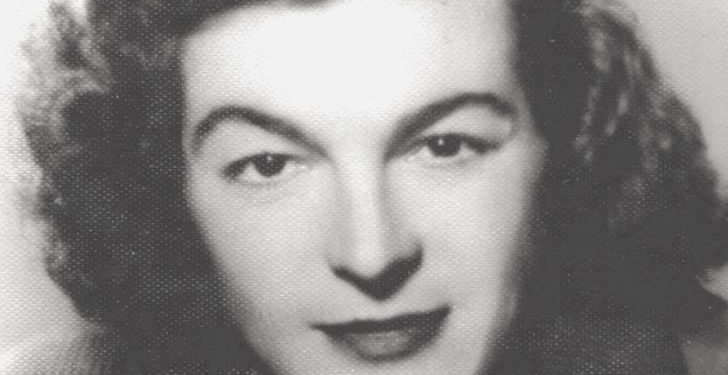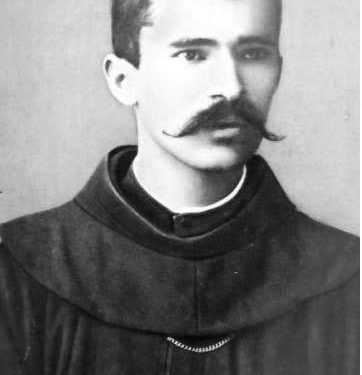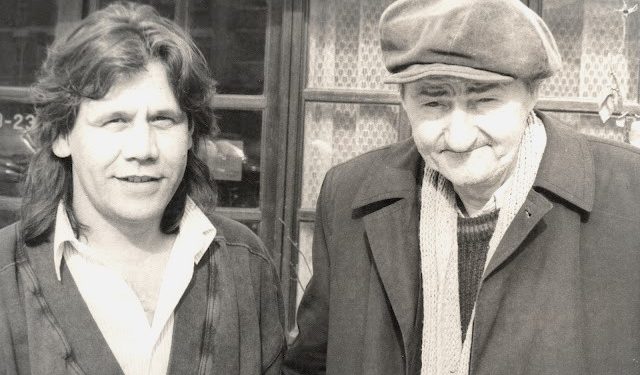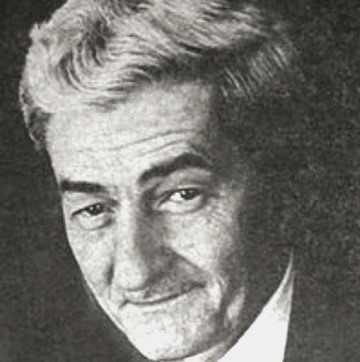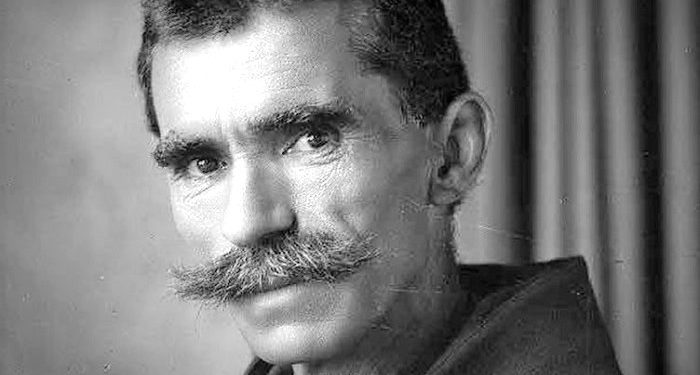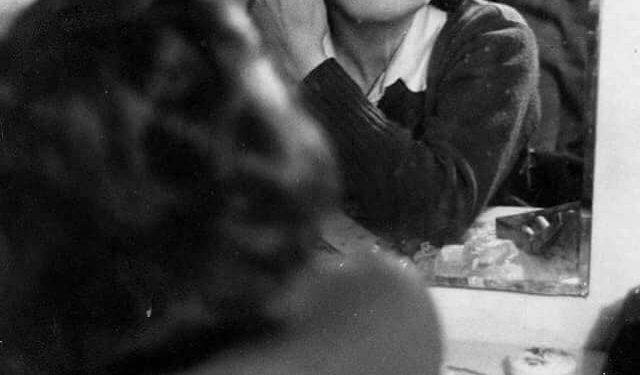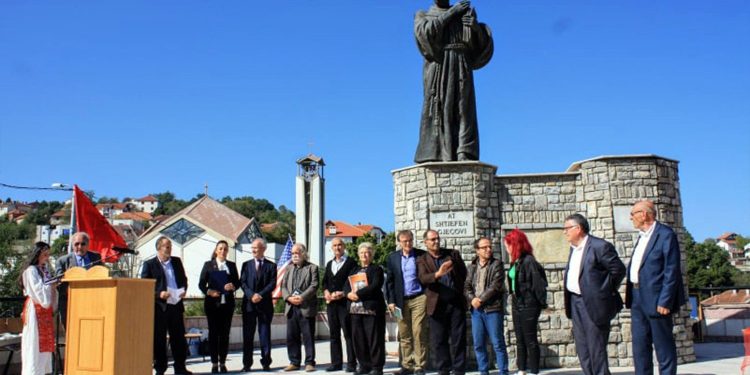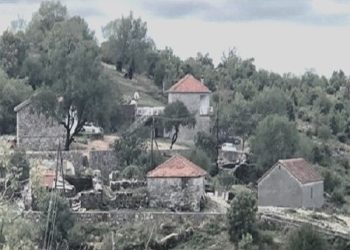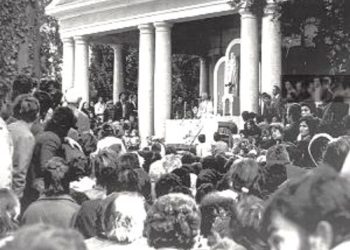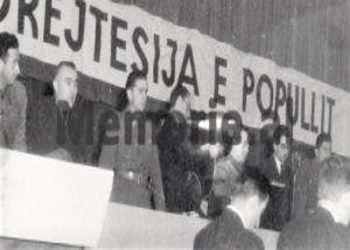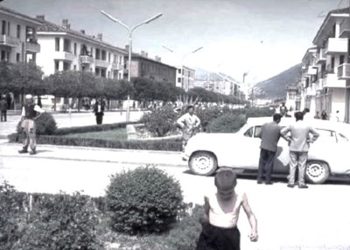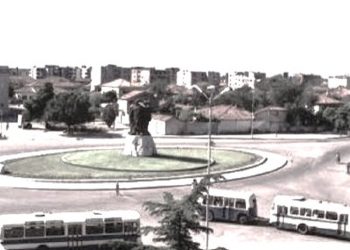Reportage in Zym of Has, where Shtjefën Gjeçovi and the writer Anton Pashku, whom Ibrahim Rugova would call; “The Joyce of Albanian literature,” rest!
Memorie.al / whoever goes to Zym, the first thing they do is ask where Shtjefën Gjeçovi rests. We are no exception. And, fate had it that we encountered the right guides. The well-known journalist Frrok Kristaj, and the history researcher, Nikollë Kërhanaj, the people who accompany us on our “meeting” with Gjeçovi, narrate his killing by the Serbs, as if it happened yesterday, even though 80 years have passed since that October 14, 1929, and they had not even been born at the time. But the details of that murder, they “remember” well, from their parents and the memory of history. This has been the nature of communication in the Albanian mountains, for ages, through songs, the narration of histories, events that travelled more by word of mouth, than through the white paper.
Gjeçovi, scholar and hero, rests inside the ruins of the Church of Shna-Premte (Saint Friday). Right there, adjacent to the writer of the Kanun, is the grave of another patriot, At Luigj Palaj, fallen in 1913, also as a martyr of the nation. Kosovo is the only place in the Balkans, where one can speak of heroes, both in the early years of the 20th century, and in the last years of that century, given that it was liberated in 1999, its penultimate year.
Someone must have called this place in Zym a “national cemetery,” as the great writer, Anton Pashku, the famous actress Katarina Josifi, the well-known soprano, Hermina Leka, etc., also rest here. But also two “interesting” graves, belonging to the two Sisters of Honour (nuns) Marie and Dila Nerjovaj, from Lugishta of Has. When the population of that village converted to the Islamic faith, in 1852, the two of them left a dying wish that, when they died, they should be brought to Shëngjergj, and so it happened.
It is no wonder at all that upheavals or historical circumstances are found even in cemeteries, like “palimpsests,” whose meaning you can grasp, to understand even more deeply the events that have occurred, even those “lines” that may be missing, in the history manuals. In Zym, for 40 years, the “Gjeçovi Meetings” have been organized, precisely by these people we have beside us as guides. Initially, they took place at the Oaks of Shna-Premte, then at the Altar nearby and finally in the new amphitheatre.
They are annual spiritual, literary, and artistic manifestations. There is always a place within these “meetings” for the “Hour of Anton Pashku,” where there are communications about the writer and his work. The meetings are attended by residents and the Albanian cultural elite of Prishtina, Ulqin, Skopje, and now also from Albania. In October of this year, it will be the 40th pan-national cultural “Meeting” with Gjeçovi and Frrok Kristaj, just like forty years ago, is once again the leader of this exemplary activity.
“THE ZYM PRIMER” OF 1900
Zymi rightly prides itself on its Albanian primer, dating back to 1900, which according to Nikollë Kërhanaj, is believed to have been mimeographed on the premises of the Zym church. This locality began the new century, the twentieth, with a solitary monument of knowledge. It may be among the rare cases, not only in the Albanian world, where a locality has its own primer!
But when you meditate on the path of the Albanian letters, over mountain crests, you understand that where Pjetër Bogdan had been, in the 17th century, why there should not be a “Zym Primer,” two centuries later. Meanwhile, the first school there had been opened as early as 1864. The Zym Primer is carved in stone, and a photograph there is a meaningful souvenir for every Albanian.
National symbolism dominates everywhere in Zym, as the core of our identity has been so well preserved there. It is enough to see even the altar of the Church of Shna-Premte, which besides being a place of worship, represents an eagle, a book, and a pillar, the latter in the sense of resistance. Our guides do not stop talking. They lead us to another cultural and identity sign of this place, and of these people.
A memorial amidst the greenery dedicated to those Zym inhabitants, who in the last decade of the 20th century (1991-1999), repeated history; when the Serbs expelled teachers and students from the school, meaning from their Albanian “primer,” they opened the doors of their homes to teach the children, turning them into schools. “It was the former President Fatmir Sejdiu, who inaugurated this memorial,” adds one of them.
The border divides Has into two almost equal parts, the Kosovo part: 241 sq. km. with 40 thousand inhabitants and the Albania part: 243 sq. km. with 21 thousand inhabitants. This datum is of little importance now, but yesterday it was different. It meant that an entire Albanian region, one of the best known, was cut in half with Serbia. But even though the Serbian state had control over the territory, we had there one of the cornerstones of our national identity.
It is mentioned that some Zym inhabitants participated in the Battle of Kosovo (1389). One of the six hypotheses on Skënderbeu’s origin, says that he was from Has i Thatë, while the following were truly from here: Pal Hasi, the Bogdani dynasty (Ndre, Pjetër, Gjon, and Lukë Bogdani), or where Mëhill Suma, Lazër Lumëzi, Ndue Bytyçi, etc., served.
Among the most distinguished had been the bishop and writer from Gjakova, Gjon Nikollë Kazazi, who had discovered Buzuku’s “Meshari” in Rome. In Zym of Has, for half a century (1702-1752), the Skopje-Prizren Bishopric had been sheltered, due to Ottoman persecutions.
We are told that two Zym inhabitants also participated in the Assembly of Arbër (in 1703) in Mërçi of Lezha, along with Bishop Pjetër Karagiqi. Zym has been called “Little Rome,” because, just like the Italian capital, it is located on seven hills, one neighbourhood on each. (This reminds us of a novella by Kasëm Trebeshina, titled “The Village on Seven Hills.”)
But this Has “Little Rome” was not like the Italian capital, where Albanians from these parts had studied theology and philosophy, or been consecrated bishops; on the contrary, it was a dry place, without sufficient water, with narrow roads, with chalky soil, as local authors describe it, which according to them, had given Zym a gloomy appearance, under the “Olympian” shadow of Pashtrik.
Today’s Zym, which is part of the Municipality of Prizren, has a stunning landscape, with large ancient oaks, the new “Gjeçovian” amphitheatre with 1000 seats, in the likeness of the one in Durrës, with two statues that seem to speak to each other; of Gjeçovi and Bogdani (nearby), the Church of the Lady, the obelisk of the Zym Primer, the primary school, the “Gjon Buzuku” gymnasium, the library, the museum, etc.
Zym has 6000 inhabitants, of the Catholic and Muslim faiths, but fewer than one third live there, as the others are in emigration, mostly in Croatia. Wise, noble people, there have never been quarrels and disputes with them; they have also acquired the culture of emigration, which means, the culture of the European countries they come from. Religious tolerance, etc., is also worth mentioning.
“LADY OF HAS, PRAY FOR US”!
“The whole Dukagjini area flocks here on this day, and comes here. There are about ten thousand people in today’s procession of our patron saint; ‘The Assumption of the Blessed Lady into Heaven’. We Albanians refer to this saint with various names, such as: Great Lady (Zoja e Madhe), Lady of Berisha, Lady of Gruda, Lady of Has, where the Saint in Letnicë of Kosovo (also called “Lady of Cernagora”) is particularly well-known, from where Mother Teresa received her calling to become a nun.
The tireless historian, Nikollë Kërhanaj, and the friar At Ndue Kajtazi, have written a monograph about the Lady of Has and her path among the inhabitants of this region, whose epithet “dry,” seems to no longer suit even the relief. In Kosovo, there is a serious effort by scholars and creators to document the history, traditions, and ethnoculture of the Albanian regions in the Dardania lands. It is truly moving to see the new flag of the state of Kosovo waving at the top of the bell tower of the Church of the Lady in Zym.
PJETËR BOGDANI IS EXPECTED TO “ARRIVE”
Pjetër Bogdani (1630 – 1689), born in Gur of Has of Prizren, the well-known author of “The Band of Prophets,” one of the first original works of Albanian literature, otherwise “the first prose work written in the Albanian language,” seems a little more distant in the daily discourse, like all the peaks that have now fully appeared, and stand up there at the top, wrapped in a little fog. “The Band of Prophets” contains Sibyls, written by the author himself, or by some relative of his.
Among them, of particular interest, is a poem by Lukë Bogdani, which vividly brings to life the memory of Skënderbeu and the author’s impressions of the grandeur of his birthplace. Pjetër Bogdani spent his life in the mountains, preaching goodness, humanism, and the resistance of the Albanians. In one of his poems, from 1685 (“Sibila Persika”), he writes: “A voice echoes in the mountains and shouts in the wilderness / to bring good tidings and a straight path / to open the century…,” where he preaches a life without vices, faults, and disputes, but only the redemption of man on the “straight path” of the church and faith.
…And behold, this enlightened colossus of our nation is expected to “ascend” to a pedestal in Zym. His statue is being sculpted by the well-known Shkodra sculptor, Sadik Spahia, in Tirana, who also made that of Gjeçovi. Each of the two statues will be three meters high, on a three-meter base. They are conceptualized as if they are “talking” to each other, just as the Albanian times of these mountains have spoken among themselves, the Middle Ages with the Renaissance.
Gjeçovi’s statue has already been placed, and that of Bogdani is expected to be finished, who was not only one of the first writers of Albanian literature but also the Bishop of Shkodra and Kosovo, and the leader of the liberation uprising of 1689.
It is already known that the ateliers of the first writers were often precisely the parish houses, as in such places, the poems of Pali of Has were written, and the “notes” of Gjon Nikollë Kazazi, and the Kanun of Gjeçovi, who sometimes published under the pseudonym, “L’keni of Has.”
ANTON PASHKU WROTE ON STONE SLABS…!
In the words of our guides in this reportage, there is emotion when Anton Pashku is mentioned. The genius of modernity in literature, as he is called in Kosovo, is beyond words. He must be read even in his beyond-silence. “He often came here to Zym in his youth, he had maternal uncles in our house (the Kërhanajs’), and perhaps when he wrote the short story ‘Nën qarr po rrinte vasha’ (‘The girl was sitting under the oak’), in 1959, (published in the book of short stories ‘Evening Prayers’), he had this three-hundred-year-old oak of ours and his sister under its shadow in mind,” says Nikolla, showing us a majestic oak in the centre of Zym.
Meanwhile, Frroku tells us something quite special which he has also published in his writings: “When Antoni came to Zym, he went with his uncles’ shepherds, to tend the livestock. And as he walked through the mountain, he wrote on stone slabs. After returning from the mountain, where they kept the livestock, Antoni carried the stone slabs he had written, from Rrethi i Bletës, Lëndinat e Shënkollit, Bunari i Ri, and up to Kroi i Laskavecit…! He stacked those slabs under the eaves of the house of one of his uncles, BAC Mark, who took care of them, as he loved Anton very much.”
Shepherds always engaged in something; carving figures of birds, making spindles, spinning wheels, or even a wooden rifle-toy for the children, but none of them wrote on slabs. Anton Pashku, with those writings or markings, seemed to be imitating the ancestors who wrote on papyri. Later, those slabs were lost, and no one knows what those marks, or written words, were. But nonetheless, his literature began there, from stone.
And of the writer whom Ibrahim Rugova would call; “The Joyce of Albanian literature.” It must have been some kind of stone semiotics, now lost, but perhaps his later literature tells us a little about what his creative codes were, which he first entrusted to the stone…! And we do nothing else but bow with deep reverence, before the stone of his grave, very close to that of Gjeçovi.
Petrit Palushi, the well-known writer from Kukës, created the “Anton Pashku Club” in Kukës years ago, which has developed a series of activities dedicated to the well-known writer, and where he surely must have thought about the future literary “Hours” of Pashku.
Moreover, in Prishtina there is a publishing house named after Anton Pashku, which continuously publishes literature.
A PRINCESS OF ALBANIAN ACTING, KATARINA JOSIPI
Kati, as the greatest actress in Kosovo was called, is spoken of only in poetic language. She has been called a “Prima Donna of Albanian Theatre,” “Icon of the Stage in Kosovo,” “The Katerina Josipi Phenomenon,” “An artistic signature par excellence,” “A unique and unrepeatable stage name,” “Pioneer of Albanian drama,” etc. The publicist and writer Frrok Kristaj, has dedicated a monograph to her.
He writes that; Kati’s name is the first stone and plank of the stage and platform of the theatre in the sweet language of the Albanian ethnic territories, outside administrative Albania. Katarina was born in Zym of Has, on November 9, 1943, where she also started primary school, in the Serbian language, after Gjeçovi’s murder. In 1948, she entered as the first Albanian woman in the People’s Theatre of Prishtina. The famous Kati did not live long, she passed away in 1969, when she was only 46 years old and “journeyed” from Prishtina, to be buried in the Zym of her birthplace.
As an older sister to the unreachable Bekim Fehmiu, with whom she acted at the Prishtina Theatre. Also, a sister to Nexhmie Pagarusha, Muharrem Qena, Ekrem Kryeziu, Hyrie Hana, Istref Begolli, and others, with whom she also acted on the Theatre stage, but also a spiritual sister to Tefta Tashko, Marie Logareci, Tinka Kurti, Mihal Popi, Besim Levonja, Pjetër Gjoka, with whom she did not have the fortune to share the stage, but only patriotism. Kati played 73 roles, creating a unique figure of the great Kosovar actress, who shone and was extinguished like a meteor in the sky of Kosovo.
Two of the cultural leaders of Zym are undoubtedly Frrok Kristaj and Nikollë Kërhanaj. They and others take care of everything related to the ceremonies, writings, titles, and emblems of this place. The last priest to arrive was Dom Ndue Ballabani, who came from Croatia. Thanks to this cultural elite, devoted teachers, students, residents, emigrants – always with their roots here – and well-wishers, there is always a cultural awareness in Zym, to be admired, embodied in several institutions, associations, monuments, publications, etc.
Whoever has served in Zym, has left a mark, a testimony, has left his name, on stones and trees. It is no coincidence that the toponyms of this area are pronounced daily: “Patër Deda’s Oak,” “Patër Pjetri’s Linden,” etc. Frrok Kristaj is the man between Zym and Prishtina. He was a journalist for “Rilindja” for many years, which he says; “was the greatest institution the Albanian nation had outside Albania.” The circulation of this daily was an average of 70-80 thousand copies, and every Kosovar had it at home.
He has also written a monograph about this “institution,” as he calls it. Kristaj was also an Albanian language teacher in Germany for several years. But, nonetheless, he is always in Zym, spiritually connected with every flower and stone of his birthplace. Just like the other noble man, Nikollë Kërhanaj, who wrote the monograph of Zym and several other books about it with such dedication?
Lucky is the place that has such knowledgeable and unpretentious leaders. You, who have been among them for a short time, cannot help but see the unbroken chain of national, clerical, and cultural leaders of these upper lands, dating back to the Middle Ages, from the priest and first writer, Pali of Has, who wrote devout poems on these mountain crests of the White Drin. Memorie.al




